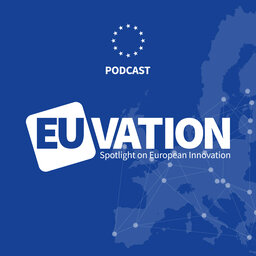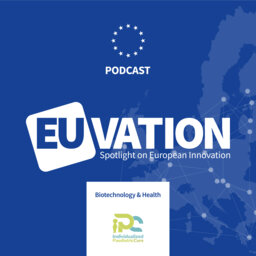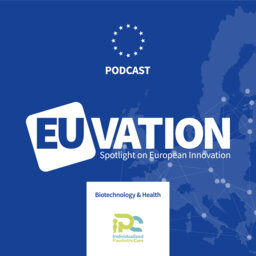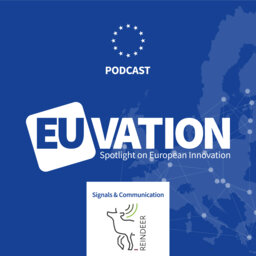SERENA (2) H2020 Project: GaN-on Silicon mm-wave systems with Cédric Corrège
The project SERENA (gan-on-Silicon Efficient mm-wave euRopean system iNtegration platform) will develop a system architecture and technology platform by using an integrated approach. In this episode we speak with Cédric Corrège from Ommic and learn about the project status and why it is important to the EU.
The SERENA project has received funding from the European Union’s Horizon 2020 research and innovation programme under grant agreement No 779305.
Powerful collaborations, cutting edge science and curious minds coming together for a glimpse of the future. Stay tuned as we look at the latest updates on some of the most promising technology projects.
Hello and welcome, I'm Peter Balint from Technikon and today we revisit the SERENA project. This is a European project which deals with developing new technologies in the antenna domain. And this has to be done because as our mobile data needs grow, the ways that the signals are transmitted has to keep up. Project partners are using gallium nitride in conjunction with silicone to help enable a new kind of beam steering antenna. This means actually pointing an antenna signal exactly where it's needed and when it's needed -with no moving parts. SERENA aims to develop an architecture which is small and cost efficient with robust thermal management schemes. Today we welcome Cédric Corrège. He joins us remotely from just outside Paris, France from the offices of Ommic. They're a developer of technology in the area of chip design and manufacturing. Ommic is a partner in SERENA. Welcome Cédric and thanks for agreeing to talk with us today.
Yes thank you very much.
We'll talk about some of the finer points of SERENA later in the program but let's start off with a little project introduction. What can you tell us?
Well SERENA is an H 2020 project that started the first January 2018 with an associated budget of the four million euro, dispatched through nine partners. So we've got partners from Austria, France, Germany and Sweden.
So truly an international project as far as Europe goes.
Truly European project, yes.
And SERENA... if you... if anyone spent some time looking at the Web site for SERENA they would realize it's a technical and complicated project. The real challenge is to try to explain it in a way which most listeners could relate to. How would you do that?
Well, there are many kind of antennas and some of them send a signal in all directions like in 4G because we want all people in this sort of a certain parameter to be able to get the signal and certain type of antenna sends the information just in a particular direction. And that can be used in like detectors or radars and you might remember old radars that used to rotate to scan all direction because the signal is sent only in one direction and the goal of the SERENA project is to make a new kind of antenna -a new generation with no moving parts but where one can orient the signal electronically. That is what we call beam steering. There are two direct applications to that. One is to orient the traffic where necessary. So for instance on the companies and industrial areas during the day and rather on homes and apartments during the evening. The other one is to reduce the total amount of electromagnetic waves by sending the signal only where it's needed. So instead of sending a large signal everywhere with everybody getting a little portion of it, the SERENA antenna will send just the amount of power needed to communicate with one person in one particular direction and follow him while he moves. And so all people around will have few to no signal which is a very interesting and very ironic when we see the mistrust about 5G.
And they do this with no moving parts?
Yes exactly. Everything is... they use electronic compounds to change the angle basically of the signal and changes direction like that.
Does this process which you call beam steering... does this require more power is that kind of one of the issues?
It does not require more power. It does require more elements. So the total power is the same because you need a certain type of power to communicate with somebody but instead of sending it everywhere we'll send it only in one direction. So actually you will use less power but you need more elements to make sure the signal goes in the right direction.
I see. If someone was to look at your web site... or the the SERENA web site, they would see that there's something called gallium nitride which sort of seems to be a key in the SERENA project. And this seems like it's using gallium nitride together with traditional silicone to achieve your goals. Is that is that an accurate statement?
Yes. Actually GaN is one of the innovative parts of the SERENA project. It's a new material that's replacing gallium arsenide that was used the previous generation of antennas. And it's a very interesting material because it can reduce the size of the amplifiers... so reducing the old form factor and also reduce the power consumption. So the new generation of antenna will be greener if we can say
You personally you are the international sales manager at Ommic which is of course, a partner in SERENA but also you are a chip foundry... you make you make microchips. What does what does Ommic bring to SERENA? I mean do you have some specialty in GaN on silicon?
The SERNA project is about mixing different technologies... and the most advanced technologies. At Ommic we have foreseen the advantages of GaN on silicon more than a decade ago and we invested heavily in the research and the development of the technology. And in the SERENA project, we have been designing and manufacturing the final parts of the antenna the front end using all of our expertise. And we are very proud of the results. In fact, I think from my young age that it might be the first time a European company is leading the development of semiconductor compounds.
Wow that's impressive. And so this makes Ommic a perfect fit for the SERENA project. Actually you're the expert in gallium nitride.
Yes, to date the technology is developed by the Americans and the Japanese and us. And we've been finding a good balance between gallium nitride on silicon carbide with very high power that most people focus on and the low power and low cost of silicon that is used in most of the electronics today by doing a GaN, gallium nitride on silicon process being able to use the advantages of both technologies so the high performance of GaN and low cost of silicon.
OK, it's a perfect combination to to get things done it sounds like. Let me ask you this -what aspect of SERENA are you most eager to see playing out in production?
Well the democratization of GaN and its potential led us to invest in a new production line. And so we started building a new six inch wafer production for GaN on silicon and I am eager to see the SERENA project move from the old prototyping line on 3 inch to the production phase with a larger volume and the new production line.
Aha, And you talk about prototyping is there... in the SERENA project a demonstrator or some sort of prototype that you have to build?
Yes. So they are two demonstrators that are planned. One is basically a 5G antenna base station. So an antenna that is supposed to be somewhere on the building or an antenna that will communicate with mobile devices. So we are doing that at 40GHz to demonstrate the capacity of millimeter waves and demonstrate it's possible to use them for the mobile. And the second part of the the project is to to make a backhaul demonstrator to connect the base station to the core network. So to explain maybe a little bit about that because it can be quite blurry when you pass a phone call, you have to communicate with an antenna to exchange information being your your voice or your data that you're sending through the internet. And this goes wirelessly to an antenna that you call a base station and this antenna will then route and send all of this information it will gather all of the different mobile devices in the area and send it through the core network with what we call the backbone part. So this part can be done using optical fiber usually because it requires to deal with a very large amount of data. But another way to do it is to send it wirelessly as well using very high frequency millimeter waves.
OK. And these these are two demonstrators that actually have to be built and working at the conclusion of the project, correct?
So we will not build the full system but just the communicating parts to demonstrate that it works and that can be put in the real system.
I see. OK. So it's a good step in the right direction; bringing this this whole concept a little bit closer to reality.
Yeah we're hoping to finalize the demonstrator this year and moving to the production phase at the end of next year.
You mentioned earlier and it's also very clear on the Web site that the SERENA project addresses wireless communication in millimeter wave systems. In other words super high frequencies. What are some of the uses of these systems? Are we talking about 5G networking here?
So millimeter wave as you mentioned are very high frequencies that can be applied to a different system and 5G is just one of them because they have a couple of advantages. The first one I would say is to be available because the rest of the spectrum is already quite occupied. And so we need new frequencies to do new applications. But by being higher frequencies -millimeter wave they have good physical properties. One of them is to increase the resolution in radars so you can see smaller objects and this can be used directly in autonomous driving for example where you can detect smaller objects and drive safely accordingly with this information. With Millimeter Wave Systems you can also increase the bandwidth to the speed of the connection. So we know that there are more and more objects connected to the internet with the IoT. We know that there's also new application that we foresee like augmented reality virtual reality that consumes a lot of data -a very massive amount of data. And so millimeter wave they allow us to have higher throughput. So you can have higher speeds. And this is used for example to replace optical fiber for fixed wireless access replacing the optical fiber for the last mile because it's usually economically more profitable and the last advantage of millimeter wave system is that you can reduce the time to connect to the server what you're communicating to so what we call the latency. This is very critical for doing real time application like remote surgery decision making for autonomous vehicle or e-sports.
And it seems like all of our applications all the things that we will use in the future will rely on these extremely high data requirements which sort of says millimeter wave systems they definitely have their place in the future.
Exactly. And this is why SERENA is paving the ground for millimeter wave system. So the main focus of the demonstrators are 5G but similar principle could be used in all of these mentioned domains because the physics is the same.
And for you personally Cédric, what does success look like in SERENA?
SERENA will be a success when production starts after the prototyping phase I think by then we will have proven that it is possible to produce innovative hardware in Europe and that the technology is ready for 5G or even 6G.
As we said earlier, this was a consortium of people that are across Europe. I'm wondering what is it like to work in a group like this there must be some setbacks or challenges that you have. I'm curious number one, what were these challenges and number two how did you overcome them?
So in such a big consortium decision making is usually the biggest challenge because there's no... the organization of work is not as known as when it's in your own company. Many people have to interact from different companies and it can be a challenge to organize ourselves to do things in the right timing and take the right decision at the right time. But looking at what we've achieved so far I think we have dealt with this issue.
Part of the European Union's idea with H 2020 projects is to become leaders in in many areas... European leaders and one of them happens to deal with industrial leadership and they actually say that Europe needs to attract more private investment in research and innovation and also that Europe needs more innovative small and medium sized enterprises to create growth and jobs. Can you point to anything specifically in SERENA that has sort of supported these two points?
So certainly with H2020, Europe is showing the way to investors by showing that we can invest in European company and they can be a return on investment. We've mentioned the increase of our production capacity adding to that. So today it's true that in France and in Europe in general it might be harder to find investors and I think Europe is doing exactly what we're doing in the SERENA project -the proof of concept showing that it's possible and open the way for a more private investment in the future.
So thanks for all the information today it's good to hear a little bit about what's happening in SERENA coming from the inside. And it's always interesting to hear about some of the latest technology and some of the challenges as well. So thanks for sharing with us today and good luck with the rest of the project.
Thank you Peter.
We'll check in again soon. Thank you.
For more information about SERENA visit serena-h2020.eu. This podcast has been brought to you by Technikon.
This project has received funding from the European Union's Horizon 2020 research and innovation program under grant agreement Number 779305.
 EUVATION: Spotlight on European Innovation
EUVATION: Spotlight on European Innovation


